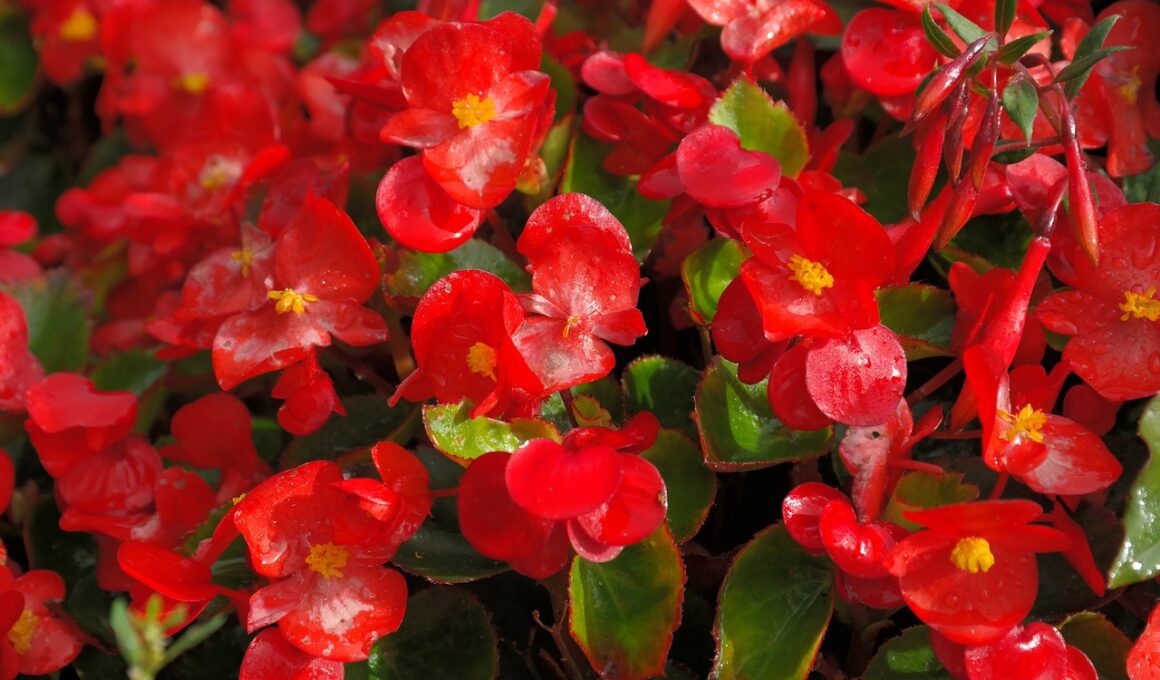Are you a begonia lover? As winter approaches, it’s time to start thinking about how to prepare your beloved plants for storage.
With a little bit of effort and attention, you can ensure that your begonias will survive the winter and thrive come springtime. In this article, you will learn how to identify the type of begonia you have, how to prepare the soil and container, how to adjust watering and lighting, and how to choose the right storage location.
By following these steps, you’ll be able to care for your begonias during winter and ensure their safety until the warmer weather arrives.
Identify the Type of Begonia
Spotting the right type of begonia is crucial before putting it away for the colder months. Identifying begonia species is important because different types of begonias have different needs. For example, tuberous begonias need to be dug up and stored indoors during the winter, while others can stay outside as long as they are protected from frost. Understanding begonia characteristics is also important because some types of begonias are more cold-hardy than others.
To identify the type of begonia you have, start by looking at the leaves. Begonias have a wide range of leaf shapes, sizes, and colors. Some begonias have variegated leaves while others have solid colors. Next, look at the flowers. Begonias can have single or double blooms in shades of pink, red, white, and yellow. Finally, check the stem and overall growth habit. Some begonias grow upright while others have a trailing habit.
Once you have identified your begonia species, you can determine the best way to prepare it for winter storage. For tuberous begonias, dig up the tubers after the foliage has died back and store them in a cool, dry place. Other types of begonias can be left outside as long as they are protected from frost. You can cover them with a blanket or tarp, or move them to a sheltered area such as a covered porch.
With a little preparation, your begonias will survive the winter and be ready to bloom again next year.
Prepare the Soil and Container
Now it’s time to get your soil and container ready for your begonias to hibernate during the colder months.
Container selection is important because it needs to be large enough to accommodate the root system of your begonia. It’s also important that the container has drainage holes to prevent water from pooling at the bottom and causing root rot.
When it comes to soil mixture, you’ll want a well-draining mix that is also nutrient-rich. A good mix can include equal parts peat moss, perlite, and vermiculite. You can also add some slow-release fertilizer to the mix to provide your begonias with the necessary nutrients throughout the winter.
In addition to preparing the soil and container, it’s also important to consider overwintering strategies and propagation tips. Overwintering strategies can include bringing your begonias indoors, providing them with adequate light, and maintaining proper humidity levels. Propagation tips can include taking cuttings from your begonias in the fall and rooting them in water or soil to create new plants for next season.
With these tips in mind, your begonias will be well-prepared for the winter months ahead.
Should I Deadhead Begonias Before Storing Them for Winter?
Before storing begonias for winter, it is advisable to deadhead begonias frequently. Removing the faded flowers promotes new growth and prevents the plant from wasting energy on seed production. Deadheading also improves the overall appearance of the plant, ensuring a vibrant and healthy begonia during the cold months.
Adjust Watering and Lighting
It’s crucial to adjust watering and lighting for your begonias during the winter months to ensure their survival.
As the days get shorter and temperatures drop, your begonias will require less water and different lighting conditions. Watering frequency should be reduced to avoid overwatering, which can lead to root rot. Make sure to check the soil moisture regularly and only water when the top inch of soil feels dry to the touch.
In addition to adjusting the watering frequency, you also need to pay attention to the lighting duration. Begonias require bright but indirect light, and during the winter, they may not receive enough sunlight. Consider placing them near a south-facing window or supplementing with artificial light. The ideal lighting duration for begonias is around 12-14 hours a day. If you notice your begonias stretching towards the light source, then they’re not receiving enough light, and you should adjust accordingly.
Finally, humidity control and fertilizer application are also essential for your begonias’ winter survival. Begonias prefer high humidity, so you can place a tray of water near them or use a humidifier. Fertilizer application should be reduced or stopped altogether during the winter months, as begonias enter a dormant phase and don’t require as many nutrients.
By adjusting watering and lighting, controlling humidity, and reducing fertilizer application, you can ensure that your begonias survive the winter and thrive come spring.
Choose the Right Storage Location
When choosing a storage location for your begonias during winter, it’s important to find a cool and dry place. Avoid freezing temperatures as this can damage the roots and kill the plant.
Additionally, it’s recommended to consider pest control measures to prevent any unwanted guests from making a home in your begonias during their winter slumber.
Find a Cool, Dry Place
Keep your begonias safe by finding a cool and dry shelter, where they can rest peacefully until spring. The benefits of cool storage are numerous, as it helps the plant to enter a dormant phase, where it conserves energy and prepares for the next growing season. This is especially important for tuberous begonias, which need to be stored properly to avoid rot or drying out.
When it comes to dry storage, there are alternatives to consider. For example, you can use sawdust or peat moss to help keep the soil moist without overwatering the plant. Additionally, you can wrap the begonia in a layer of newspaper or burlap to protect it from drafts and temperature fluctuations.
Remember that the key to successful winter storage is to find a place where the temperature remains between 40-50°F and the humidity is low. With a little bit of care, your begonias will be ready to bloom again next spring!
Avoid Freezing Temperatures
Make sure your begonias stay away from freezing temperatures to avoid any damage to the delicate plant. Winter protection is crucial for begonias, and keeping them insulated is the key. The best way to do this is to use insulation methods, which can include wrapping the plant with a cloth, placing it in a cardboard box, or covering it with a plastic bag.
When it comes to insulation methods, it’s important to remember not to suffocate the plant. It still needs air to breathe, so make sure to leave some ventilation. Also, keep in mind that different begonia varieties have different temperature preferences, so do some research and adjust your insulation methods accordingly.
With proper winter protection and insulation, your begonias should survive the cold winter months and come back to life in the spring.
Consider Pest Control Measures
To ensure the health and longevity of your begonias, it’s important to take preventative measures against pests by regularly inspecting and treating your plants.
One effective way to control pests is by introducing natural predators such as ladybugs, lacewings, and praying mantises into your garden. These predators can help control common pests like aphids, spider mites, and whiteflies, without the use of harmful chemicals.
Another option is to use non-toxic repellents like neem oil or insecticidal soap. These products are plant-based and won’t harm your begonias or the environment. Simply apply the repellent to the leaves and stems of your plants according to the manufacturer’s instructions.
Regular application can help prevent pests from infesting your begonias and causing damage. By taking these steps, you can help ensure that your begonias stay healthy and pest-free throughout the winter season.
Care for Your Begonias During Winter
As the temperatures start to drop, it’s important to give your begonias some extra TLC to help them survive the winter months.
Here are three things you can do to care for your begonias during winter:
-
Reduce watering: During winter, your begonias will require less watering than they do in warmer months. Overwatering can cause root rot, so make sure you allow the soil to dry out before watering again. It’s also a good idea to water your begonias in the morning to give them enough time to dry before the temperature drops at night.
-
Provide enough light: Begonias need light to survive, so make sure they receive enough sunlight during the winter months. If you’re growing your begonias indoors, place them in a well-lit area, like a south-facing window. If you’re growing them outdoors, make sure they’re not in the shade of other plants.
-
Keep an eye out for pests: Even though your begonias are indoors or in winter planters, pests can still be a problem. Check your plants regularly for any signs of infestation, like yellowing leaves or sticky residue. If you do spot pests, take action immediately by removing the affected leaves or using an insecticidal soap.
By following these three tips, you can help your begonias survive the winter and thrive in the spring.
Remember, taking care of your plants during the winter months is just as important as taking care of them during the growing season. With a little extra attention, your begonias will be healthy and beautiful all year round.
Frequently Asked Questions
How do I know if my begonias are suitable for winter storage?
To ensure that your begonias are suitable for winter storage, it’s important to first identify the type of begonia you have. Tuberous begonias are the most common variety that can be stored over winter, while fibrous and rhizomatous begonias should be kept indoors.
Once you’ve identified your begonia, it’s important to provide optimal storage conditions. This includes keeping them in a cool and dry location, such as a basement, garage, or unheated room. It’s also important to periodically check on them throughout the winter to ensure they aren’t drying out or developing mold.
By following these simple steps, you can safely store your begonias over the winter and ensure they thrive come springtime.
Can I store my begonias in a garage or shed?
When it comes to storing your begonias for the winter, you may be wondering if your garage or shed is a suitable location.
The answer is that it depends on the temperature requirements for your specific type of begonia. Some begonias can tolerate cooler temperatures, while others require a consistently warm environment.
If your begonia needs warmer storage, then a garage or shed may not be ideal, as the temperature fluctuations can be too drastic. However, if your begonia can handle cooler temperatures, then a garage or shed may work fine as long as it is above freezing.
Just be sure to monitor the temperature regularly and adjust as needed to ensure your begonia stays safe and healthy throughout the winter.
Do I need to prune my begonias before storing them for winter?
To ensure the survival of your begonias during winter, proper preparation is key. Pruning techniques are essential to maintain the health of your plant.
Best practices suggest that you begin by cutting back any dead or damaged foliage. Next, trim the stems to a length of about 6 inches. This will encourage new growth and make for a fuller plant come spring.
Remember to remove any flowers or buds, as this can use up valuable energy that your begonia needs to survive the winter.
By following these simple pruning techniques, you can ensure that your begonias are ready for winter storage and will bloom beautifully come spring.
How often should I check on my begonias during winter storage?
During winter care, it’s important to keep an eye on your begonias while they’re in dormancy. Check on them every few weeks to make sure they’re not drying out or experiencing any other issues.
It’s also a good idea to store them in a cool and dry place, away from any direct sunlight or extreme temperatures. By taking these simple steps, you can help ensure that your begonias stay healthy and safe during the winter months.
Can I propagate my begonias during winter storage?
To propagate your begonias during winter storage, there are a few methods you can use. One method is to take stem cuttings and propagate them in water or soil.
Another method is to divide the plant by separating the root ball into smaller sections. Ideal conditions for propagation include keeping the cuttings or divided sections in a warm and humid environment with plenty of indirect light.
It’s important to keep an eye on the cuttings or divided sections and make sure they stay moist, but not too wet. With the right care and attention, you can successfully propagate your begonias during winter storage.
Conclusion
Congratulations! You’ve successfully learned how to prepare your begonias for winter storage.
By identifying the type of begonia you have, preparing the soil and container, adjusting watering and lighting, and choosing the right storage location, you’ve set yourself up for success.
However, don’t forget to continue caring for your begonias during the winter months. Keep an eye on the temperature and humidity levels in your storage area, and make sure to water your plant when the soil is dry.
With a little extra effort, your begonias will thrive and be ready to bloom again come springtime. Happy gardening!









